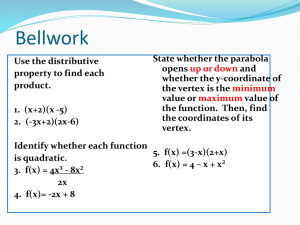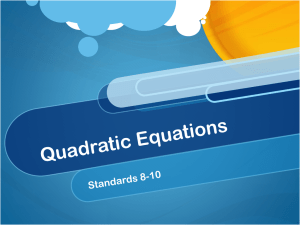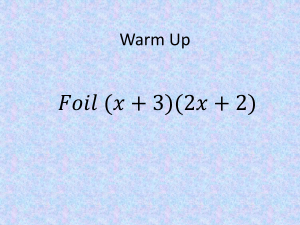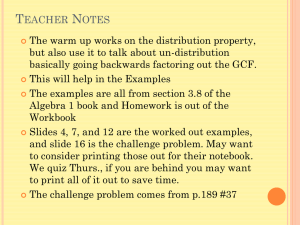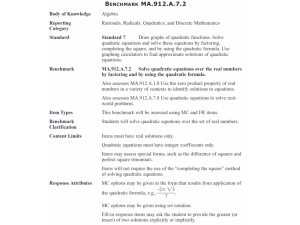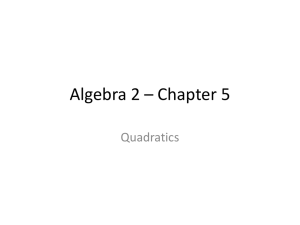File
advertisement
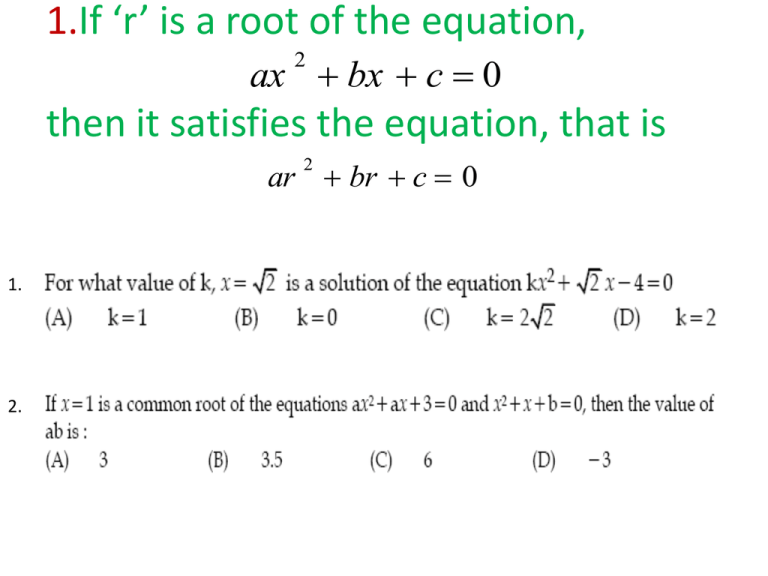
1.If ‘r’ is a root of the equation, ax bx c 0 2 then it satisfies the equation, that is ar br c 0 2 1. 2. Assignment 3. 2.Discriminant =D = b 4 ac D>0, real and unequal roots D=0, equal roots D<0, no real roots 2 4. 5. 6. 7. Assignment 8. 9. 10. 11. 3. Solving by factorization that is splitting the middle term. 12. 13. 14. Note that in questions like the two above, the splitting is the same as given in the problem. In the second one just open the brackets and take common. 15. Assignment 16. Note that both the first and the last terms of the expression on the LHS are perfect squares. That should prompt one to check whether the entire expression is a perfect square. The equation can also be written as : a b x 2 2 ( a b ) x 4 ( a b ) 4 ( a b ) 2 0 4. Quadratic formula 17. 18. 5. Completion of square method 19.(i) (ii) The equations above can be solved easily by both quadratic formula as well as completion of square method. Try to solve it using both!! 6. Which method to use to solve a quadratic equation if not mentioned in question? • If the coefficients are small, you should first try to split the middle term. If the split is not clear or is not striking quickly then move to another method. • Use completion of square method only if the coefficient of x2 is 1 or is a perfect square. If you can remember the common binomial squares or even learn to recognise them this method can be very handy in some cases. • Examples of binomial squares are : x 2 x 1 x 1 2 2 x 6 x 9 x 3 2 2 4 x 4 x 1 2 x 1 2 2 • The quadratic formula method works in all cases. But when the split is clear the calculations in the formula method may be unnecessarily tedious. • Be perfect with the quadratic formula!! 7. Word problems method • Since the word problems have rational or integer solutions most of the time after getting the quadratic equation , first try to solve it by splitting the middle term. • Do remember to discard the irrelevant solution and write the final answer. • 8.Framing equations for word problems (simpler ones) Consider the following problem : 20. • Look for what is asked. Take it as x. • In this case let the number of packets bought be ‘x’. Then 4 more packets means x+4 packets. Now the problem reads : • A shopkeeper buys x packets of biscuits for Rs 80. If he had bought x+4 packets for same amount (that is 80), each packet would have cost Re. 1 less. • Thus new cost of each packet = old cost of each packet – 1 • Cost of each packet = total cost /no. of packets. • Now you should be able to get the equation. Simplify and solve it to get 16 as your answer. You will also get –20 as your answer which you can discard. Now try these: 21. 22. 23. 24. 8.Framing equations for word problems (digit problem) 25. In these problems, instead of taking the no. as ‘x’, take one of the digits as ‘x’. Let the ones digit be ‘x’ in this problem, then given product of digits is 18, the tens digit will be 18 . x Thus the number= 18 10 x 1 x 18 x 10 1 And the number obtained by interchanging the digits = x Now frame the equation, multiply the equation by ‘x’ to remove ‘x’ from the denominator and you will end up with a quadratic equation to solve. • Similar to the digit problem is the fraction problem where either numerator or denominator is taken as ‘x’. Try these problems: 26. 9.Framing equations for word problems (distance time problem) • Consider the following problem: • • We start by taking usual speed of the train as ‘x’ km/hr. There are two cases in the problem.First when the speed is ‘x’ and second case when the speed is increased by 5 km/hr that is the speed is (x+5) km/hr. The distance in both cases is 150 km. Now we can find the time taken in both the cases. Time = distance/speed First case the time taken is 150/x hr Second case the time taken is 150/(x+5) hr Given time taken in second case is one hour less than the time taken in first case. That is 27. • • • • • • 150 • x5 Now solve the equation. 150 x 1 Now try these problems: 28. 29. 30. 31. 10.Framing equations for word problems (work -time problem or tap problem) • Remember in work time problems time taken is inversely propotional to number of men or number of taps. So if the time taken by one man is t1 , the time taken by another man is t2 and the time taken by both together to finish a work is t, then t t1 t 2 • Rather the correct relation is 1 t1 1 t2 1 t • Consider the following problem 32. • Let the time taken by smaller tap be x hrs. • Then the time taken by larger tap will be (x – 10) hrs • Thus from the previous slide • 1 x 1 x 10 1 9 3 or 1 x 1 x 10 8 • Now simplify and solve the equation 8 75 Now try these problems: 33. 34. 35. 36. ANSWERS

